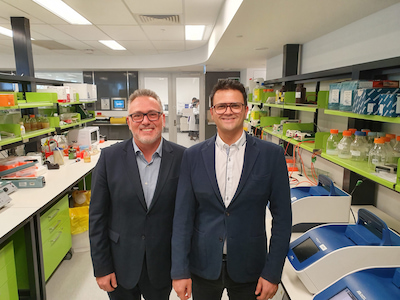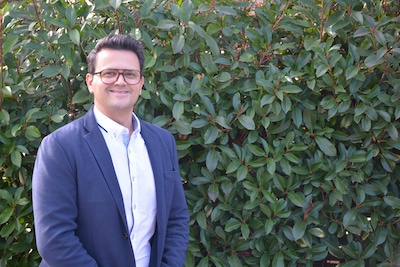Q&A: Dr Peter Diamond – our head of research
 Head of the Leukaemia Foundation’s National Research Program, Dr Peter Diamond discusses his role, priorities for the program, and exciting breakthroughs coming up in blood cancer research.
Head of the Leukaemia Foundation’s National Research Program, Dr Peter Diamond discusses his role, priorities for the program, and exciting breakthroughs coming up in blood cancer research.
What does your role as Head of Research involve?
I work closely with leading researchers, research institutions and organisations to identify emerging treatment trends and Australia’s newest and most exciting blood cancer research and clinical trials. These opportunities are presented to the Leukaemia Foundation’s Board of Directors to decide which projects we will fund through our National Research Program. Our overall aim is to strengthen the blood cancer research ecosystem in Australia. A strong blood cancer community in Australia leads to better treatment outcomes and improved access for all people living with a blood cancer.
What does a typical day at work look like for you?
I spend a lot of my time on the phone speaking to researchers and others about blood cancer research and new opportunities for the Leukaemia Foundation to be involved in. To be able to make informed funding recommendations, I’m always reading scientific literature and attending scientific/clinical meetings. Therefore, a lot of my day is devoted to keeping up-to-date with new trends in research and discovering where new breakthroughs in treatment will come from. Another increasingly important part of my role is to raise awareness about what research the Leukaemia Foundation is funding, what exciting breakthroughs and clinical practice changes this research is generating, and ensuring this information is communicated in a way that everyone can understand.
What excites you most about your role?
I know that every significant improvement in treatment is a direct result of investment in research. By creating partnerships and funding the best research and clinical trials in Australia, we will make a difference for everyone living with blood cancer. Clinical research is moving at a rapid pace and I’m excited to be part of supporting this process; to develop better treatments and ultimately cures for blood cancer. I am also grateful to be a member of the Leukaemia Foundation’s Blood Cancer Partnership team which leads advocacy within the community and government. Our bipartisan approach was very successful in getting blood cancer on the political agenda during the recent Federal election.
What motivates you every day in your role?
The thing that motivates me the most is seeing how what we do every day is helping someone. Sadly, I know all too well what it is like to have family members diagnosed with cancer, to see them go through treatment, to revel in the joy of every remission and to be devastated by every relapse. And, I’ve also seen some eventually lose their battle. I would like to live in a world where no one else watches their nieces and nephews grow up without a mum or dad, or a parent saying goodbye to their child because of blood cancer.
What’s the biggest challenge you face in your role?
There are so many great research projects, but we only have a limited amount of money to invest in research. If only we could fund all of them! We actively partner with other organisations, to pool our resources and fund a greater number of projects. Our current research partnerships are with Cancer Australia, the Haematology Society of Australia and New Zealand, Tour de Cure, Leukemia & Lymphoma Society (U.S.) and Snowdome Foundation. We’re always looking for new partners to collaborate with who share our vision.
What do you believe is the ‘next big thing’ in blood cancer research?

There’s no doubt, it’s genomics and precision medicine. Genomics looks at your genetic makeup to understand what genetic mutations may be driving your cancer. And precision medicine, also known as personalised medicine, is where a therapy is tailored to an individual. This means people are treated with targeted therapies which are based on their genetic makeup and mutations and the treatment is not just based on their disease. An example is imatinib (Glivec®) which was one of the first targeted drugs on the market. It specifically targets a genetic mutation found in many individuals with chronic myeloid leukaemia (CML). This drug revolutionised CML treatment and has crossed over into treatments for some acute lymphoblastic leukaemias (ALL). Imatinib started a wave of new targeted therapies over the past 20 years which are now at the forefront of research today
In coming years, what will be the major focus on the National Research Program?
Our commitment is to fund research innovations that drive rapid advancements in treatment, that discover new diagnostics and new therapies, and to enable Australian patients have access to the newest therapies available through clinical trials. The Leukaemia Foundation has a long and proud history of supporting research. Over the last 20 years, we have invested more than $47 million in research and clinical trials and have supported most major haematologists and senior blood cancer researchers in Australia at some stage of their careers. We will continue to support the development of tomorrow’s leading researchers and haematologists through our PhD scholarships and early career investigator initiatives while also investing in ongoing research and clinical trials. Over the next 3-5 years, we will support an exciting initiative – a precision medicine clinical trial program that has been piloted by the Garvan Institute of Medical Research (Sydney) for solid tumours. We will be extending the pilot to include blood cancers, in collaboration with Tour de Cure and expect to kick this off in early-2020.
Can you touch on the role/importance of clinical trials in blood cancer research?
Clinical trials have always had an important role in blood cancer and are a critical part of the research and development of new treatments, as well as improving current treatments. By taking part in a clinical trial, individuals can access the latest treatments on offer, potentially many years before they are available on the Pharmaceutical Benefits Scheme (PBS). Unfortunately, less than 20% of Australians living with blood cancer have participated in a trial. The reason? People either don’t know a trial is available to them (because no one has ever talked to them about this opportunity) or they think clinical trials are only for people who are not responding to current treatment. I urge everyone to discuss clinical trials with their treatment teams. There may be something out there for you.
What would you say to Leukaemia Foundation stakeholders (supporters/beneficiaries) who support the research program?
Once again, I would highlight that every significant improvement in treatment for people living with blood cancer has come from an investment in research. Without our supporters, we wouldn’t be able to invest directly in the important research work being undertaken by the best and brightest scientists and haematologists in Australia. This may be a small country, population-wise, but our scientific output and contribution is significant and of a very high quality. The harsh reality is that with our ageing population, the number of people being diagnosed with blood cancer will continue to increase. By 2025, it is predicted that every day, 50 people will be diagnosed with a blood cancer. We need better, more targeted treatments and the only way we can achieve that is by investing in research and clinical trials.
What sparked your interest in the blood cancer and research fields?
When I was a child, I was fascinated by biology and the inner workings of the human body. My family, like many others, has been touched by cancer many times and I wanted to do something that made a difference. This led me into science, a PhD in cancer immunology and a research career spanning almost 20 years, focused on understanding the genetic causes of cancer and the development of precision medicines as treatment options. After a three-year assignment working overseas, helping to implement HIV programs across South-East Asia, I started working for the Leukaemia Foundation and have been here for the last five years.
Who has inspired you in work and/or life and why?
In my time at the Leukaemia Foundation, I have been inspired by some of the greatest scientific and medical minds in the country, but also draw inspiration from the unsung heroes. Those who work quietly in the background; the technicians, research assistances, nurses, therapists, social workers and, most importantly, our amazing volunteers who will probably never get their name in the media or be acknowledged with an Order of Australia Medal or Nobel Prize for medicine. Without their hard work and determination, we couldn’t provide the level of care and support we provide and receive in Australia, nor would we have the big breakthroughs in medicine to celebrate.
What interests do you have that help create work-life balance?
My parents instilled in me a love of gardening and growing my own produce. As a child you could always find me with a shovel, digging something up, and covered in dirt. Not much has changed, I still like to spend time pottering about and cooking with what I have grown in my garden. I live near the beach and love to get down there as much as possible too, especially in summer.
Last updated on June 8th, 2022
Developed by the Leukaemia Foundation in consultation with people living with a blood cancer, Leukaemia Foundation support staff, haematology nursing staff and/or Australian clinical haematologists. This content is provided for information purposes only and we urge you to always seek advice from a registered health care professional for diagnosis, treatment and answers to your medical questions, including the suitability of a particular therapy, service, product or treatment in your circumstances. The Leukaemia Foundation shall not bear any liability for any person relying on the materials contained on this website. Head of the Leukaemia Foundation’s
Head of the Leukaemia Foundation’s